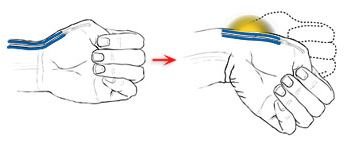DE QUERVAIN’S TENDINITIS
De Quervain tendinitis occurs when the tendons around the base of the thumb (where the thumb meets the wrist bones) are irritated or constricted. The word “tendinitis” refers to swelling of the tendons. Symptoms include pain, swelling, and tenderness along the thumb side of the wrist. The pain is particularly noticeable when forming a fist, grasping or gripping things, or when turning the wrist. The goal of treatment is to relieve the pain caused by irritation and swelling.
De Quervain’s tendinitis (also called tenosynovitis) occurs when the tendons around the base of the thumb where the thumb meets the wrist bones become irritated or constricted. The word “tendinitis” means swelling of the tendons. The tendons of the thumb glide smoothly through a tunnel, known as the tendon sheath. Repetitive movements can irritate the sheath and the tendons. Both can swell, which restricts the tendons from gliding through the sheath smoothly. While the exact cause of the tendinitis is unknown, repetitive movements of the wrist and hand can make it worse. Certain activities like gardening and playing tennis or golf can irritate the tendons.
Symptoms include pain, swelling, and tenderness along the thumb side of the wrist. Grasping objects, making a fist or turning your wrist can be painful with this condition. The goal of treatment is to relieve the pain caused by the irritation and swelling. Initial treatment includes icing the joint and taking anti-inflammatory medications to reduce inflammation. Injection of a steroid medication around the tendons may also relieve the symptoms. Wearing a splint can reduce pain by allowing the joint to rest and protecting the area. Surgery may be an option when non-surgical treatment stops working, which involves opening the tendon sheath to allow more room for the tendons to glide smoothly.

